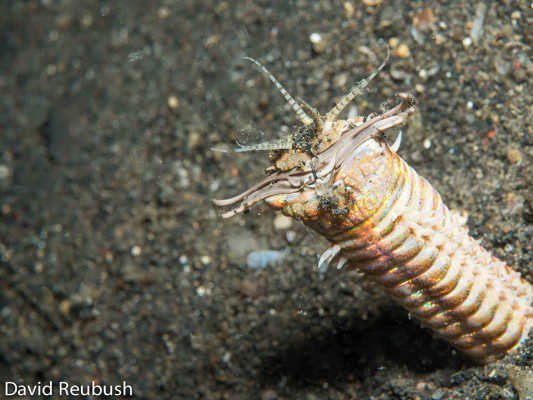
Bobbit worms belong to a group known as polychaetes, which just means they’re a kind of bristly marine worm. These creatures can grow quite long—some reach lengths of up to 10 feet! If you’re picturing a brightly colored creature waving about in the water, hold onto that thought. Bobbit worms come in various colors, including green, brown, and even red. So, what’s it like living as a Bobbit worm? Let’s take a closer look at what makes these fascinating creatures so special.
What Exactly Is a Bobbit Worm?
Bobbit worms, scientifically known as *Eunice aphroditois*, are not your average worms. They have a long, serpentine body that can stretch anywhere from 3 to 10 feet long. They generally hide within a burrow they create in the sand or mud on the sea floor. Think of them as the homebodies of the ocean world, preferring to stay tucked away, waiting for the perfect moment to pounce on unsuspecting prey.
These worms are named after a rather infamous incident involving a certain John Bobbitt, which is a story for another time. Their predatory nature, however, is where the real intrigue lies. Bobbit worms have strong jaws and can capture prey quickly, often using their sharp teeth. They’re like underwater ninjas, striking from their hidden lairs with lightning speed. Imagine lounging on the beach and suddenly seeing a worm launch out of the sand—that’s the Bobbit worm in action!
Physical Characteristics of Bobbit Worms
You might be wondering what exactly sets Bobbit worms apart from other marine creatures. For starters, their size is impressive. Some can reach lengths up to 10 feet, while most average around 3-4 feet. They have a segmented body, which is covered in bristles. These bristles help them move and can even be used for defense if they’re threatened.
Another fascinating feature is their color. Bobbit worms can vary widely—some are a bright green or red, while others sport a more muted brown or grey. This color variation helps them blend into their environments, making it easier to ambush prey. Imagine hanging out at a party and suddenly realizing that the person you thought was just wall art is actually the life of the party—this is how Bobbit worms operate in their habitats!
Where Do Bobbit Worms Live?
Bobbit worms are found in warm, tropical oceans around the world. They prefer shallow waters, often dwelling in sandy or muddy bottoms near coral reefs. Think of them as the ocean’s version of introverts, snuggling into their cozy burrows while the hustle and bustle of reef life happens around them.
Some popular locations where Bobbit worms can be found include the Caribbean Sea, the Indonesian waters, and other tropical ocean regions. They thrive in areas where there’s plenty of marine life, which provides a steady food supply. So, if you’re diving in these regions, you might just catch a glimpse of their slick, rapid movements!
How Do Bobbit Worms Hunt?
Here’s where things get really interesting. Bobbit worms are master hunters. They use a clever ambush tactic. Most of the time, they lie in wait, barely visible, with only their heads poking out of their burrows. When a fish or crustacean swims by, the worm strikes with its powerful jaws and quickly traps its prey.
Their jaws can snap shut with surprising speed and strength, making it nearly impossible for the victim to escape. Think of it like a cat waiting for the perfect moment to pounce on a toy mouse. The element of surprise is key! Once caught, the worm drags its prey back into the burrow to feast. This method ensures that they get enough nutrients to grow and thrive in their oceanic home.
Life Cycle of a Bobbit Worm
The life cycle of a Bobbit worm is an intriguing journey. It begins when the female lays thousands of eggs in the water. These eggs hatch into tiny larvae that drift in the ocean currents until they settle on the ocean floor. Once settled, they start to grow and gradually develop their iconic worm-like shape.
As they mature, they excavate their burrows and adapt to their environment. Over time, these larvae transform into the fearsome predators we recognize today. It’s a bit like a superhero origin story, where the little worm evolves into a creature of the deep, capable of hunting and defending itself. This transformation is crucial for their survival in the competitive marine ecosystem.
Why Are Bobbit Worms Important to Their Ecosystem?
Bobbit worms might seem like just another underwater creature, but they play a significant role in their ecosystems. By preying on various fish and crustaceans, they help maintain a balance in the marine food web. This predation can control the populations of other species, ensuring that no single species dominates the environment.
Additionally, their burrowing habits help aerate the ocean floor, promoting healthy sediment and water movement. This, in turn, benefits other marine creatures living nearby, contributing to a thriving reef ecosystem. They may not receive the limelight like dolphins or sharks, but these worms are crucial to maintaining the health and balance of their underwater homes.
Bobbit worms are truly remarkable creatures that add a unique layer to the rich tapestry of marine life. From their impressive hunting skills to their impactful role in the ocean ecosystem, there’s much to appreciate about these underwater ambush predators. So, next time you’re near a tropical reef or enjoying a beach day, think of the hidden Bobbit worm lurking beneath the sands, ready to showcase its skills in the world beneath the waves.
Exploring the ocean’s depths unveils countless wonders, and the Bobbit worm is just one intriguing example. Understanding these creatures helps foster a deeper appreciation for the biodiversity in our oceans and emphasizes the importance of protecting their habitats for future generations.
